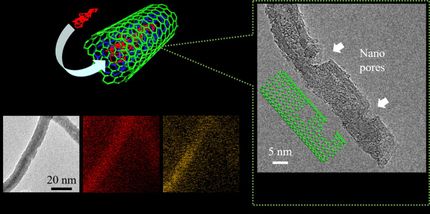Super-nanotubes: 'Remarkable' spray-on coating combines carbon nanotubes with ceramic
Researchers from the National Institute of Standards and Technology (NIST) and Kansas State University have demonstrated a spray-on mixture of carbon nanotubes and ceramic that has unprecedented ability to resist damage while absorbing laser light.
Coatings that absorb as much of the energy of high-powered lasers as possible without breaking down are essential for optical power detectors that measure the output of such lasers, which are used, for example, in military equipment for defusing unexploded mines. The new material improves on NIST's earlier version of a spray-on nanotube coating for optical power detectors** and has already attracted industry interest.
"It really is remarkable material," NIST co-author John Lehman says. "It's a way to make super-nanotubes. It has the optical, thermal and electrical properties of nanotubes with the robustness of the high-temperature ceramic."
The composite was developed by Kansas State. NIST researchers suggested using toluene to uniformly coat individual nanotubes with a ceramic shell. They also performed damage studies showing how well the composite tolerates exposure to laser light.
NIST has developed and maintained optical power standards for decades. In recent years, NIST researchers have coated optical detectors with nanotubes because of their unusual combination of desirable properties, including intense black color for maximum light absorption.
The new composite consists of multiwall carbon nanotubes and a ceramic made of silicon, boron, carbon and nitrogen. Boron boosts the temperature at which the material breaks down. The nanotubes were dispersed in toluene, to which a clear liquid polymer containing boron was added drop by drop, and the mixture was heated to 1,100 degrees C. The resulting composite was then crushed into a fine powder, dispersed in toluene, and sprayed in a thin coat on copper surfaces. Researchers baked the test specimens and then exposed them to a far-infrared laser beam of the type used to cut hard materials.
Analysis revealed that the coating absorbed 97.5 percent of the light and tolerated 15 kilowatts of laser power per square centimeter for 10 seconds. This is about 50 percent higher damage tolerance than other research groups have reported for similar coatings—such as nanotubes alone and carbon paint—tested with the same wavelength of light, according to the paper. The nanotubes and graphene-like carbon absorb light uniformly and transmit heat well, while the oxidation-resistant ceramic boosts damage resistance. The spray-on material also adheres well to the copper surface. As an added bonus, the composite can be produced easily in large quantities.
After light exposure, the coatings were analyzed using several different techniques. Electron microscopy revealed no major destruction such as burning or deformation. Other tests showed the coating to be adaptable, with the ceramic shell partially oxidizing into a stable layer of silicon dioxide (quartz).
Original publication
Original publication
R. Bhandavat, A. Feldman, C. Cromer, J. Lehman and G. Singh, Very high laser-damage threshold of polymer-derived Si(B)CNCarbon nanotube composite coatings. ACS Applied Materials & Interfaces. ASAP Publication Date March 19. , 2013
Topics
Organizations
Other news from the department science
These products might interest you

OCA 200 by DataPhysics
Using contact angle meter to comprehensively characterise wetting behaviour, solids, and liquids
With its intuitive software and as a modular system, the OCA 200 answers to all customers’ needs

Tailor-made products for specific applications by IPC Process Center
Granulates and pellets - we develop and manufacture the perfect solution for you
Agglomeration of powders, pelletising of powders and fluids, coating with melts and polymers

Dursan by SilcoTek
Innovative coating revolutionizes LC analysis
Stainless steel components with the performance of PEEK - inert, robust and cost-effective

Get the chemical industry in your inbox
By submitting this form you agree that LUMITOS AG will send you the newsletter(s) selected above by email. Your data will not be passed on to third parties. Your data will be stored and processed in accordance with our data protection regulations. LUMITOS may contact you by email for the purpose of advertising or market and opinion surveys. You can revoke your consent at any time without giving reasons to LUMITOS AG, Ernst-Augustin-Str. 2, 12489 Berlin, Germany or by e-mail at revoke@lumitos.com with effect for the future. In addition, each email contains a link to unsubscribe from the corresponding newsletter.
Most read news
More news from our other portals
Last viewed contents
OCSiAl Builds Worldwide Partnership Network

Researchers use lead recycled from car batteries to make photodetectors - Recycling strategy could keep lead out of landfills and give used car batteries a second life in high-tech equipment

New electrolyte for solid-state lithium-ion batteries - New battery material offers promise for the development of all-solid batteries
BASF Board of Executive Directors - New team as of 2008
BASF to set up Electronic Materials R&D Center Asia Pacific - Facility to open in 2014

Nanomaterial helps store solar energy: efficiently and inexpensively - Field trials show that new catalyst material for electrolysers is reliable
Australia's HealthLinx Collaborates with Bruker Daltonics on Mass Spectrometry-Based Disease-Specific IVD Assays





























































